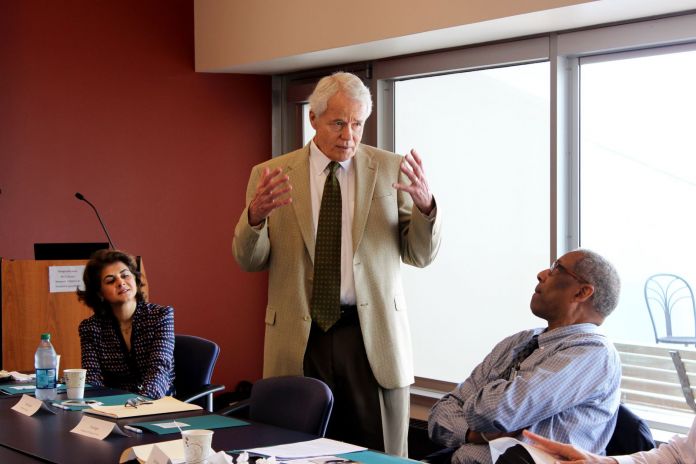
Upon Reflection: Recalling a Great Newspaper Editor and What He Represented
This column is a periodic series of personal reflections on journalism, news literacy, education and related topics by NLP’s founder and CEO, Alan C. Miller. Columns are posted at 10 a.m. ET every other Thursday.
John Carroll was the kind of editor who made you proud to be a journalist. He inspired those who worked for him. In my case, I felt honored to call him my editor, my chairman, my friend.
John led with vision, integrity and courage. He loved a good story, especially when it held the powerful accountable. His courtly manner belied a steely resolve and an uncompromising commitment to the highest standards of journalism. I thought of him as the iron fist in the velvet glove.
This month will mark six years since John’s death at 73 from Creutzfeldt-Jakob disease, a rare and unforgiving degenerative brain disorder. It was a devastating loss for those of us who knew and revered him. It was also an indelible loss for journalism, and for the country.
Norm Pearlstine, a prominent editor in his own right who had remained close to John since their days as Haverford College classmates, said at his friend’s memorial, “John Carroll was our generation’s greatest, most respected and most beloved editor.”
In many respects, John’s story reflects the trajectory of American journalism in the 21st century. He pushed back against the growing challenges that threatened the health of newspapers, the partisan attacks on journalism, and the rise of misinformation. Sadly, these forces have only accelerated since his passing.
I first met John when he was named the editor of the Los Angeles Times in 2000 and I was an investigative reporter in the paper’s Washington bureau. He had been editor of The Baltimore Sun (1991-2000) and, prior to that, the Lexington (Kentucky) Herald-Leader (1979-1991), shepherding both papers to Pulitzer Prizes.
John took over a demoralized staff reeling from the disclosure that the Times had published a special issue of its Sunday magazine devoted entirely to the Staples Center, a new downtown sports arena, and split advertising revenue from that issue with the arena — a fundamental breach of journalism ethics. He recommitted the paper to its high standards, recruited talented reporters and editors from across the country and reaffirmed the power and honor of journalism at its best.
When he detected a left-leaning slant to some of the paper’s coverage, he made it clear that this was unacceptable. When he learned that a veteran staff photographer covering the Iraq war had digitally manipulated an image, he promptly fired him and explained to readers why such an ethical breach was so egregious. He called factual errors “the pollution of our business” and insisted that they be promptly corrected.
Under John’s leadership, the paper revealed that the U.S. Food and Drug Administration had approved seven drugs that subsequently were suspected of contributing to more than 1,000 deaths; it detailed the high price in blood and treasure of the Marine Corps’ deeply troubled aviation program; it revealed deadly medical problems and racial injustice at the Martin Luther King Jr./Drew Medical Center, a public hospital in Los Angeles; and it published “Enrique’s Journey,” an exhaustive and moving account of a Honduran boy’s harrowing journey to reunite with his mother, who had migrated to the United States 11 years earlier. These projects each won Pulitzer Prizes — five of the 13 that the paper captured during John’s extraordinary five-year tenure (“Enrique’s Journey” won for both feature writing and feature photography). I embraced the opportunity to work closely with John on the Marine Corps aviation series as well as on other projects.
In his eulogy, Dean Baquet, hired by John as the Times’ managing editor (and now the executive editor of The New York Times), called John’s success in Los Angeles “one of the finest acts of leadership — in a newsroom or anywhere else — in modern times.” He quoted a colleague as saying that watching John run the paper “was like watching Willie Mays play baseball.”
But it wasn’t enough. The business model for newspapers was collapsing. The internet had led to steep declines in both advertising and circulation as readers gravitated to free online competitors. Family-run papers and companies, finding it harder and harder to stay afloat, were being consolidated by new owners focused on shrinking the bottom line.
The Tribune Company, which had purchased the Los Angeles Times in 2000 in the aftermath of the Staples Center debacle and then hired John to run it, began demanding ever-deeper budget cuts to maintain profit margins — a demand, John said, that would kill the newsroom. Amid the widening rift between John and Tribune executives in Chicago, he stepped down in 2005.
A year later, in accepting the American Society of Newspaper Editors Leadership Award, John asked what would become of newspapers: “What will become of the kind of public service journalism that newspapers produce? … What will the public know — and what will the public not know — if our poorly understood, and often unappreciated, craft perishes in the Darwinian jungle?”
Those questions have only become more urgent. Since then, more than 2,000 newspapers in the United States have shut down, and many others have cut their staffs.
The three papers that John edited have been vastly diminished. The Herald-Leader and the rest of the once-proud, family-run McClatchy chain were purchased by Chatham Asset Management, a hedge fund, in a bankruptcy sale last year. The Baltimore Sun and other papers in the Tribune chain were acquired last month by Alden Global Capital, another hedge fund notorious for slashing newspaper staffs and selling their assets.
The Los Angeles Times suffered through a string of corporate overlords who ranged from inept to malevolent, as well as a stint when Tribune was in bankruptcy. In 2018, the paper was purchased by Patrick Soon-Shiong, a Los Angeles biotech billionaire. Pearlstine, John’s longtime friend, was the new owner’s first executive editor and presided over an initial period marked by hiring and hope. But he stepped down last year amid internal strife and reports of ethical lapses by multiple staffers, as well as financial losses and disappointing growth in digital subscriptions.
For his part, after leaving newspapers, John embarked on a new fight to retain an appreciation for the journalistic values to which he had devoted his illustrious career.
In 2008, he accepted my invitation to become one of the initial board members of the News Literacy Project, the education nonprofit that I left the Los Angeles Times to create. Our purpose was (and still is) to use journalism standards — and journalists — to help teach students how to know what they can trust, share and act on and what they should dismiss and debunk, and to give them an understanding of what sets quality journalism apart.
John served seven years on our board, including four as chairman — helping to get NLP off to a strong start and move to national scale. His reputation, devotion to the cause and managerial acumen were invaluable. It was his final principled service to the preservation of a healthy democracy.
“It is important for us to understand, in clear English, what, exactly, a journalist is, and what a journalist is not,” John said in his 2006 ASNE speech. “It is important for us to live by those beliefs, too, and to condemn those who use the trappings of journalism to engage in marketing or propaganda. And, finally, it is important for us to explain to the public why journalism — real journalism, practiced in good faith — is absolutely essential to a self-governing nation.”
John Carroll embodied journalism’s highest values. Emulating him would be both a fitting legacy and a fine way to preserve them.
Read more from this series:
- Apr. 8: The 19th* — a nonprofit news startup made for the moment
- Mar. 25: How I became a ‘pinhead’ — a news literacy lesson
- Mar. 11: Fighting the good fight to ensure that facts cannot be ignored
- Feb. 26: Students’ enduring rights to freedoms of speech and the press
- Feb. 11: We need news literacy education to bolster democracy
- Jan 28: 13 lessons from our first 13 years
- Jan. 14: Media needs to get COVID-19 vaccine story right
- Dec. 17: Journalism’s real ‘fake news’ problem also reflects its accountability
- Dec. 3: Combating America’s alternative realities before it’s too late
- Nov. 12: “Kind of a miracle,” kind of a mess, and the case for election reform
- Oct. 29: High stakes for calling the election
- Oct. 15: In praise of investigative reporting
- Oct. 1: How to spot and avoid spreading fake news
